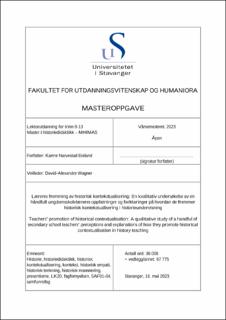| dc.contributor.advisor | Wagner, David-Alexandre | |
| dc.contributor.author | Eieland, Karine Narvestad | |
| dc.date.accessioned | 2023-07-01T15:51:30Z | |
| dc.date.available | 2023-07-01T15:51:30Z | |
| dc.date.issued | 2023 | |
| dc.identifier | no.uis:inspera:146751713:35200519 | |
| dc.identifier.uri | https://hdl.handle.net/11250/3075062 | |
| dc.description.abstract | Formålet med dette kvalitative forskningsarbeidet er å kartlegge hvordan lærere mener at de fremmer historisk kontekstualisering i historieundervisning. Historisk kontekstualisering innebærer å inneha og bruke kunnskap om sammenhengene rundt et historisk fenomen, for å forstå og tolke fenomenet. Det handler om å forsøke å forstå fortida ut ifra fortidas premisser, og ikke gjennom nåtidas premisser. I LK20 nevnes ikke historisk kontekstualisering eksplisitt, men det gjennomsyrer hele læreplanen ved det økte fokuset på at en skal anvende historiekunnskapene, ikke bare inneha dem.
For å undersøke dette har jeg brukt Huijgen et al. (2017b) sin observasjonsmodell, som deler opp historisk kontekstualisering i forskjellige aktiviteter innunder fire kategorier: 1) rekonstruere historisk kontekst, 2) fremme historisk empati, 3) bruke historisk kontekst for å forklare historiske hendelser, og 4) bevisstgjøring av nåtidsorienterte perspektiver. Det ble også skilt mellom aktiviteter der læreren formidler, og aktiviteter der læreren aktiviserer elevene. I forskningsprosjektet deltok åtte ungdomsskolelærere på en spørreundersøkelse der de skulle ta stilling hvorvidt de selv, og elevene, gjør disse aktivitetene, samt hvilke aktiviteter de anser som viktigst å gjøre. Spørreundersøkelsen ble etterfulgt av individuelle intervju der lærerne ble spurt om utdyping av svarene gitt i spørreundersøkelsen. For å videre analysere besvarelsene og intervjuene, ble det foretatt en innholdsanalyse.
Resultatene viser at lærerne forteller at de gjør mye i arbeid med historisk kontekstualisering. Lærerne formidler heller historisk kontekstualisering, i stedet for å aktivere elevene i prosessen selv, til tross for at de mener at det er viktigst at elevrollen er den mest aktive. Lærerne kontekstualiserer i hovedsak gjennom å rekonstruere den historiske konteksten, og dette syns de også er det viktigste. Det som gjøres mindre av, er å bruke historisk kontekst for å forklare historiske hendelser, og å fremme historisk empati. Resultatene viser også at det er stor variasjon innad i lærerutvalget på hva de gjør, og hva de syns er viktigst i arbeid med historisk kontekstualisering. Funnene viser at lærerne ser ut til å trenge mer veiledning i hvordan de skal bevege seg bort ifra det tradisjonelle, faktaorienterte historielærersynet, mot å anvende faktakunnskapene, for å i større grad fremme historisk kontekstualisering i historieundervisning. | |
| dc.description.abstract | The aim of this qualitative research study is to explore how history teachers believe they promote historical contextualisation in their lessons. Historical contextualisation is the ability to both have, and use knowledge of the circumstances regarding a historical phenomenon, to better understand and interpret the phenomenon. It involves the process of understanding the past on its own terms, not through the terms of the present. In the Norwegian curriculum, historical contextualisation is not mentioned explicitly, but it is ingrained in the entire curriculum with the increased focus on applying historical knowledge, not just possessing them.
This was investigated by using the observation model of Huijgen et al. (2017b), that divides historical contextualisation into different activities under four categories: 1) reconstructing historical context, 2) enhancing historical empathy, 3) use historical context to explain historical events, and 4) raising awareness of present-oriented perspectives. A distinction between activities where the teacher demonstrates historical contextualisation and activities focusing on engaging student in historical contextualisation processes, was also made. Eight secondary history teachers participated in the study. First, they took part in a survey in which they evaluated their ability in promoting historical contextualisation. Thereafter, the survey was followed by individual interviews in which the teachers were asked to elaborate the answers given in the survey.
The results indicate that the teachers consider themselves to promote historical contextualisation to a large extent in their lessons. The teachers mainly demonstrated historical contextualisation, while engaging students in historical contextualisation processes was said to be promoted far less often, even though/ despite the fact that the teachers considered engaging students in historical contextualisation processes as the most important. The teachers mainly contextualize through reconstructing the historical context, which is also considered the most important. What is being done less often, is using historical context to explain historical events, and promoting historical empathy. The results also show a great variation within the teachers in the sample regarding what they do, and what they think is most important to do in promoting historical contextualisation. The findings indicate that history teachers need more guidance in how to move away from the traditional fact-oriented view of history teaching, towards applying historical knowledge, to promote students' ability to perform historical contextualisation to a greater extent. | |
| dc.language | nob | |
| dc.publisher | uis | |
| dc.title | Læreres fremming av historisk kontekstualisering: En kvalitativ undersøkelse av en håndfull ungdomsskolelæreres oppfatninger og forklaringer på hvordan de fremmer historisk kontekstualisering i historieundervisning | |
| dc.type | Master thesis | |
